Miele G 856 SC ELITE User Manual
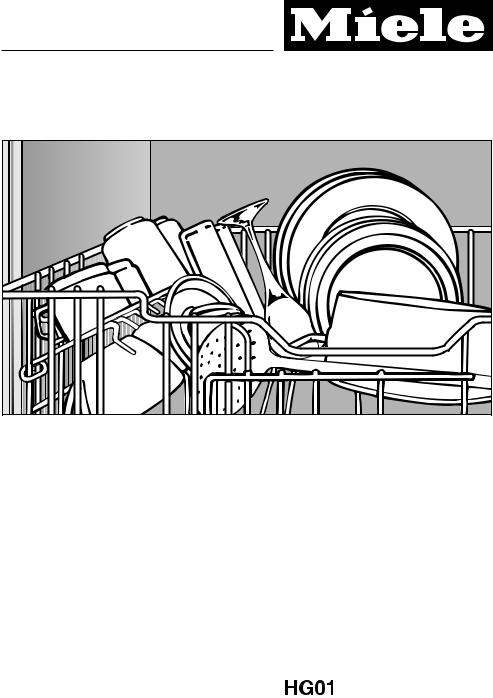
Operating instructions
Novotronic
G 856 SC Elite
To prevent accidents |
|
UV |
|
||
and machine damage, |
|
|
read these instructions |
|
|
before |
|
|
installation or use. |
|
M.-Nr. 05 431 320 |
|
2

Contents
IMPORTANT SAFETY INSTRUCTIONS
MESURES DE SÉCURITÉ IMPORTANTES
Caring for the environment
Energy saving washing . . . . . . . . . . . . . . . . . . . . . . . . . . . . . . . . . . . . . . . . . . . . . . 9
Guide to the dishwasher
Wash cabinet . . . . . . . . . . . . . . . . . . . . . . . . . . . . . . . . . . . . . . . . . . . . . . . . . . . . . 10 Control panel . . . . . . . . . . . . . . . . . . . . . . . . . . . . . . . . . . . . . . . . . . . . . . . . . . . . . 11
Before using for the first time
To open the door . . . . . . . . . . . . . . . . . . . . . . . . . . . . . . . . . . . . . . . . . . . . . . . . . . 12 To close the door . . . . . . . . . . . . . . . . . . . . . . . . . . . . . . . . . . . . . . . . . . . . . . . . . . 12 Child Safety Lock. . . . . . . . . . . . . . . . . . . . . . . . . . . . . . . . . . . . . . . . . . . . . . . . . . 12 Water softener . . . . . . . . . . . . . . . . . . . . . . . . . . . . . . . . . . . . . . . . . . . . . . . . . . . . 13 Programming the water softener . . . . . . . . . . . . . . . . . . . . . . . . . . . . . . . . . . . 14 Checking the programmed water hardness. . . . . . . . . . . . . . . . . . . . . . . . . . . 15 Salt indicator . . . . . . . . . . . . . . . . . . . . . . . . . . . . . . . . . . . . . . . . . . . . . . . . . . . . . 17 Rinse aid . . . . . . . . . . . . . . . . . . . . . . . . . . . . . . . . . . . . . . . . . . . . . . . . . . . . . . . . 18 Adding rinse aid . . . . . . . . . . . . . . . . . . . . . . . . . . . . . . . . . . . . . . . . . . . . . . . . . . 18 Adjusting the dosage. . . . . . . . . . . . . . . . . . . . . . . . . . . . . . . . . . . . . . . . . . . . . . . 19 Rinse aid indicator . . . . . . . . . . . . . . . . . . . . . . . . . . . . . . . . . . . . . . . . . . . . . . . . . 19
Loading the dishwasher
Items not recommended for dishwashing . . . . . . . . . . . . . . . . . . . . . . . . . . . . . . . 21 Cutlery tray (SC units) . . . . . . . . . . . . . . . . . . . . . . . . . . . . . . . . . . . . . . . . . . . . . . 22 Upper basket . . . . . . . . . . . . . . . . . . . . . . . . . . . . . . . . . . . . . . . . . . . . . . . . . . . . . 23 Adjusting the upper basket . . . . . . . . . . . . . . . . . . . . . . . . . . . . . . . . . . . . . . . 23 Adjustable cup racks . . . . . . . . . . . . . . . . . . . . . . . . . . . . . . . . . . . . . . . . . . . . 24 Coffee bar . . . . . . . . . . . . . . . . . . . . . . . . . . . . . . . . . . . . . . . . . . . . . . . . . . . . . 24 Lower basket . . . . . . . . . . . . . . . . . . . . . . . . . . . . . . . . . . . . . . . . . . . . . . . . . . . . . 25
Lower basket inserts
Removing an insert . . . . . . . . . . . . . . . . . . . . . . . . . . . . . . . . . . . . . . . . . . . . . 26 Inserting an insert . . . . . . . . . . . . . . . . . . . . . . . . . . . . . . . . . . . . . . . . . . . . . . . 26 Foldable spike insert . . . . . . . . . . . . . . . . . . . . . . . . . . . . . . . . . . . . . . . . . . . . 27 PlateGuard Plus insert . . . . . . . . . . . . . . . . . . . . . . . . . . . . . . . . . . . . . . . . . . . 28 Bottle holder . . . . . . . . . . . . . . . . . . . . . . . . . . . . . . . . . . . . . . . . . . . . . . . . . . . 28
Basket accessories
3

Contents
Operation
Adding detergent. . . . . . . . . . . . . . . . . . . . . . . . . . . . . . . . . . . . . . . . . . . . . . . . . . 30 Running the dishwasher . . . . . . . . . . . . . . . . . . . . . . . . . . . . . . . . . . . . . . . . . . . . 31 Program sequence indicator (14) . . . . . . . . . . . . . . . . . . . . . . . . . . . . . . . . . . . . . 31 At the end of a program. . . . . . . . . . . . . . . . . . . . . . . . . . . . . . . . . . . . . . . . . . . . . 32 Interrupting a program. . . . . . . . . . . . . . . . . . . . . . . . . . . . . . . . . . . . . . . . . . . . . . 32 Changing a program . . . . . . . . . . . . . . . . . . . . . . . . . . . . . . . . . . . . . . . . . . . . . . . 32 Program guide . . . . . . . . . . . . . . . . . . . . . . . . . . . . . . . . . . . . . . . . . . . . . . . . . . . . 33 Additional features . . . . . . . . . . . . . . . . . . . . . . . . . . . . . . . . . . . . . . . . . . . . . . . . . 34
"Top Solo" (15). . . . . . . . . . . . . . . . . . . . . . . . . . . . . . . . . . . . . . . . . . . . . . . . . . 34 Delay Start (18). . . . . . . . . . . . . . . . . . . . . . . . . . . . . . . . . . . . . . . . . . . . . . . . . 35 Extended drying . . . . . . . . . . . . . . . . . . . . . . . . . . . . . . . . . . . . . . . . . . . . . . . . 37
Frequently asked questions
After sales service
Transport
User Maintenance Instructions
Cleaning the filter in the wash cabinet. . . . . . . . . . . . . . . . . . . . . . . . . . . . . . . . . . 46 Cleaning the spray arms . . . . . . . . . . . . . . . . . . . . . . . . . . . . . . . . . . . . . . . . . . . . 48 Cleaning the wash cabinet . . . . . . . . . . . . . . . . . . . . . . . . . . . . . . . . . . . . . . . . . . 49 Cleaning the door and door seal . . . . . . . . . . . . . . . . . . . . . . . . . . . . . . . . . . . . . . 49 Cleaning the exterior . . . . . . . . . . . . . . . . . . . . . . . . . . . . . . . . . . . . . . . . . . . . . . . 49 Cleaning the water inlet filter . . . . . . . . . . . . . . . . . . . . . . . . . . . . . . . . . . . . . . . . . 50 Cleaning the drain pump and non-return valve. . . . . . . . . . . . . . . . . . . . . . . . . . . 51
4

IMPORTANT SAFETY INSTRUCTIONS
WARNING –
When using your dishwasher, follow basic precautions, including the following:
Read all instructions before installation or use of the dishwasher to prevent injury and machine damage.
The manufacturer cannot be held responsible for damage or injury caused by improper use of this appliance.
Use the dishwasher only for its intended purpose. This appliance is intended for residential use only.
Keep these operating instructions in a safe place and pass them on to any future user.
Electrical safety
Before installation make sure that the voltage and frequency listed on
the data plate correspond with the household electrical supply. This data must correspond to prevent injury and machine damage. Consult a qualified electrician if in doubt.
Before installation or service, disconnect the power supply to the
work area by unplugging the unit, “tripping” the circuit breaker or removing the fuse.
Do not use an extension cord to connect this appliance to electric-
ity. Extension cords do not guarantee the required safety of the appliance (e.g. danger of overheating).
Be certain your appliance is properly installed and grounded by a
qualified technician. To guarantee the electrical safety of this appliance, continuity must exist between the appliance and an effective grounding system. It is imperative that this basic safety requirement be met. If there is any doubt, have the electrical system of the house checked by a qualified electrician. The manufacturer cannot be held responsible for damages caused by the lack, or inadequacy of, an effective grounding system.
Installation
Installation and repair work should be by a Miele authorized service
technician. Work by unqualified persons could be dangerous and could void the warranty.
This equipment is not designed for maritime use or for use in mobile
installations such as caravans or aircraft. However, under certain conditions it may be possible for an installation in these applications. Please contact the nearest Miele dealer or the Miele Technical Service Department with specific requirements.
Inspect the dishwasher for shipping damage. Do not install or op-
erate a damaged unit. Contact the place of purchase.
5

IMPORTANT SAFETY INSTRUCTIONS
Ensure that any plastic wrappings, bags etc. are disposed of safely
and kept out of the reach of babies and young children. Danger of suffocation!
This dishwasher should only be installed under a continuous
countertop secured to adjacent cabinetry.
Do not install this dishwasher beneath a cooking surface or oven.
Do not, under any circumstances cut the intake hose or submerge in
liquid. This hose contains electrical components that could cause injury or property damage if cut or submerged.
Use
Only use the dishwasher if all panels are properly in place.
Do not tamper with the controls.
To reduce the risk of injury, do not allow children to play in, on, or
near the dishwasher.
Do not abuse, sit, or stand on the door or baskets of the dishwasher.
Under certain conditions, hydrogen gas may be produced in a hot
water system that has not been used for two weeks or more. HYDROGEN GAS IS EXPLOSIVE. If the hot water system has not been used for such a period, turn on all hot water faucets and let water flow from each for several minutes before using the dishwasher. This will release any accumulated hydrogen gas. Do not smoke or use an open flame during this time.
Do not wash plastic items unless they are labeled "dishwasher safe"
or the equivalent. For items not labeled, check the manufacturer’s recommendations.
When loading tableware, place sharp items away from the door seal to prevent damage to the seal. Load knives pointing downwards to
prevent injuries.
Only use detergents and rinse aids recommended for residential dishwashers. Keep all detergents and rinse
aids out of the reach of children.
Do not drink water from the dishwasher! Harmful residues could be
present.
For dishwashers with visible heating element
Do not touch the heating element during or immediately after use.
Disposal of an appliance
If the appliance is removed from its installation and will not be used,
the door to the wash cabinet should be removed to prevent children from being locked in the machine. When discarding an old dishwasher, unplug it from the power outlet, remove the door to the wash cabinet and cut off the power cord.
SAVE THESE
INSTRUCTIONS
6

MESURES DE SÉCURITÉ IMPORTANTES
AVERTISSEMENT –
Au moment d’utiliser votre lave-vaisselle, veuillez observer toutes les mesures de sécurité de base.
Cet appareil électroménager est conforme à tous les règlements et codes sur la sécurité. Pour éviter de vous blesser et d’endommager l’appareil, veuillez lire soigneusement les instructions sur l’utilisation.
N’utilisez le lave vaiselle que pour laver la vaiselle.
Le fabricant ne peut être tenu responsable des dommages ou blessures causés par une utilisation inadéquate ou par des utilisations autres que celles auxquelles l’appareil est destiné.
Les réparations doivent être effectuées uniquement par une per-
sonne compétente. Débrancher l’appareil de la prise de courant avant d’en faire l’entretien (enlever la fiche de la prise ou fermer le disjoncteur).
Installer uniquement ce lave-vais- selle sous un comptoir continu qui
est fixé à des meubles adjacents.
Vous devez mettre le lave-vaisselle à la terre. Installer le lave-vaisselle en observant les instructions pour l’ins-
tallation ci-jointes.
Utiliser des détersifs pour les lave-vaiselle ménagers seulement.
Utiliser uniquement des détersifs et des produits de rinçage recommandés pour les lave-vaisselle.
Ne pas utiliser votre lave-vaisselle à moins que tous les panneaux
soient bien en place.
Ne pas permettre aux enfants de jouer dans ou sur le lave-vaisselle.
Ranger tous les détersifs et produits de rinçage hors de la portée
des enfants.
Ne pas modifier les commandes.
Ne pas boire l’eau du meuble de lavage.
7

MESURES DE SÉCURITÉ IMPORTANTES
Au moment de remplir le lave-vais- selle :
–Mettre les articles pointus de manière à ce qu’ils n’endommagent pas le seau étanche de la porte.
–Mettre le tranchant des couteaux vers le bas afin de réduir les risques de blessure.
Ne pas laver les articles en plastique à moins qu’ils n’indiquent "Va
au lave-vaisselle" ou l’équivalent. Vérifier les recommandations du fabricant poir les articles non étiquetés.
Dans certaines conditions, un système d’eau chaude qui n’a pas été utilisé pendant plus de deux semaines,
peut dégager de l’azote.
L’AZOTE EST EXPLOSIF. Si le système d’eau chaude n’a pas été utilisé pendant une telle période de temps, ouvrir tous les robinets d’eau chaude et laisser l’eau couler pendant plusieurs minutes avant d’utiliser le lave-vaisselle. Ceci dissipera tout l’azote accumulé. Ne pas fumer ni utiliser une flamme nue durant ce temps.
Ne pas abuser et ne pas vous asseoir ni vous tenir sur la porte ou
sur les paniers du lave-vaisselle.
Enlever la porte et couper le cordon du lave-vaisselle avant de l’en-
lever aux déchets afin d’empêcher les enfants de se blesser ou de s’enfermer dans l’appareil par accident.
Lave-vaiselle avec l’élément chauffant
Ne touchez pas l’élément chauffant pendant le fonctionnement de l’ap-
pareil ou immédiatement après.
CONSERVER CES INSTRUCTIONS
8

Caring for the environment
Energy saving washing
This dishwasher is exceptionally economical in the use of water and electricity. For best results follow these tips:
^For lowest energy consumption and the gentlest washing of china and crystal, connect the dishwasher to a cold water source.
^For fastest possible wash times, yet higher energy consumption, connect the dishwasher to a hot water source.
^Make full use of the baskets without overloading for the most economical washing.
^Choose a program that best suits the degree of soiling and the type of dishes being washed.
^For small loads:
Select the "Top Solo" feature (see "Additional features").
^If baskets are only half full, select the "Economy" program.
^Use the correct amounts of detergent and rinse aid.
9
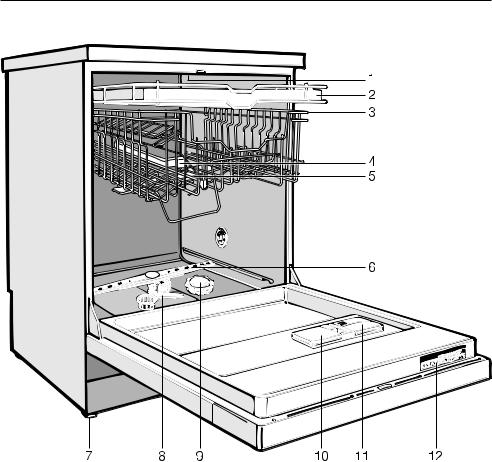
Guide to the dishwasher
Wash cabinet
1 |
Upper spray arm (not visible) |
7 |
Four height adjustable feet |
2 |
Cutlery tray |
8 |
Triple Filter System |
3 |
Upper basket |
9 |
Salt reservoir |
4 |
Water feed for middle spray arm |
10 |
Detergent dispenser |
5 |
Middle spray arm |
11 |
Rinse aid reservoir |
6 |
Lower spray arm |
12 |
Data plate |
10
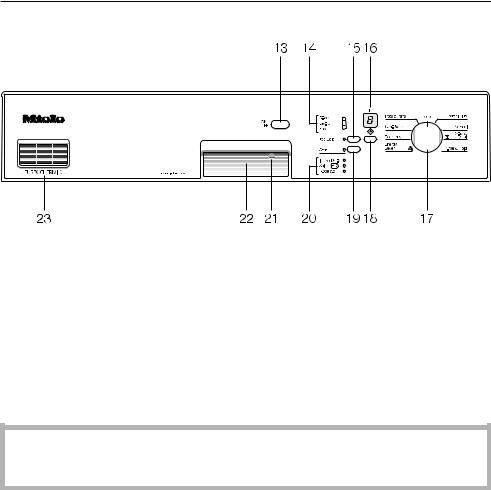
Guide to the dishwasher
Control panel
13 |
"On/Off" button |
19 |
"Start" button |
14 |
Program sequence display |
20 |
Check/Refill indicators |
15 |
"Top Solo" button |
21 |
Child Safety Lock |
16 |
Delay Start display |
22 |
Door release |
17 |
Program selector |
23 |
Drying vent |
18 |
"Delay Start" button |
|
|
Every dishwasher is tested before leaving the factory. Any water remaining in the machine is from these tests and does not indicate that the machine has been used.
11
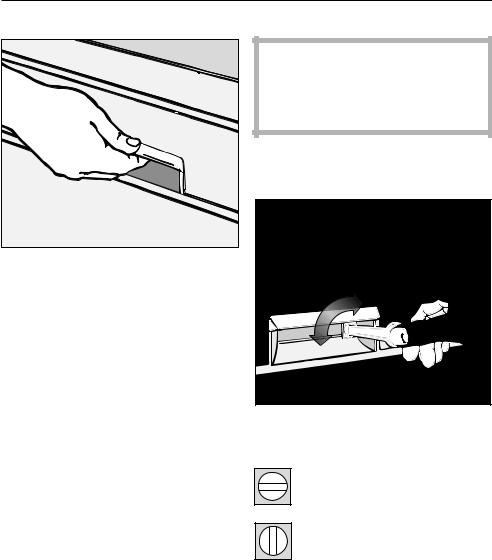
Before using for the first time
To open the door |
Child Safety Lock |
^Press the release catch inside the door grip.
If the door is opened during operation, the dishwasher will stop running. Once the door is closed the program will restart.
To close the door
^Push the baskets in.
^Lift the door and push until it clicks into position.
The yellow key for the Child Safety Lock is shipped on one of the spikes at the front of the upper basket. Remove the key before using the dishwasher.
The Child Safety Lock is designed to prevent children from opening the dishwasher.
^Use the provided key to lock or unlock the dishwasher.
Horizontal:
the door is locked
Vertical:
the door can be opened
12

Before using for the first time
Water softener
To achieve good cleaning results, the dishwasher needs soft water. Hard water results in calcium deposits on dishware and in the dishwasher.
If your tap water hardness is above 8 gr/gal (values are in US gallons) (140 ppm), the water should be soft-
ened. This takes place automatically in the unit’s integrated water softener.
–Your local water authority will be able to advise you of the water hardness level in your area.
–The dishwasher must be programmed to correspond to the water hardness in your area.
–The water softener must be filled with dishwasher salt for reactivation.
If your water hardness is consistently lower than 8 gr/gal (140 ppm), you do not need to add dishwasher salt. However, the dishwasher must still be programmed to correspond to the local water hardness.
Where the water hardness fluctuates e.g. between 9 - 17 gr/gal (160 - 310 ppm), always program the machine to the higher value, 17 gr/gal (310 ppm) in this example.
If there is a fault, it will help the service technician to know the hardness of your local water supply.
^ Please note the water hardness:
gr/gal
13
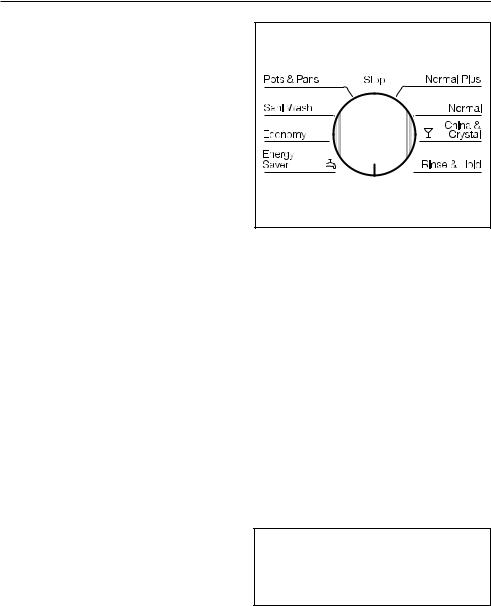
Before using for the first time
Programming the water softener
Your water hardness level must be programmed into the dishwasher using the program selector and buttons on the control panel.
^Make sure the dishwasher is turned off.
^Turn the program selector to "Stop".
^Press and hold the "Top Solo" button and at the same time turn on the dishwasher with the "On/Off" button. Release the "Top Solo" button within two seconds.
The "Salt" indicator will flash.
If the "Rinse aid" indicator comes on, the rinse aid dispenser needs to be filled.
If any other indicator is lit or flashing, the above steps must be repeated.
^Turn the program selector to the position which corresponds to the water hardness in your area (see table).
gr/gal* |
ppm |
|
Selector setting |
||
|
|
|
|
|
|
1 - |
4** |
20 |
- |
70 |
Normal Plus |
|
|
|
|
|
|
5 |
- 7 |
90 |
- |
130 |
Normal |
|
|
|
|
|
|
8 |
- 10 |
140 |
- |
180 |
China & Crystal |
|
|
|
|
|
|
11 |
- 13 |
200 |
- |
230 |
Rinse & Hold |
|
|
|
|
|
|
14 |
- 16 |
250 |
- |
290 |
5 o’clock position |
|
|
|
|
|
|
17 |
- 22 |
310 |
- |
400 |
6 o’clock position |
|
|
|
|
|
|
23 |
- 35 |
410 |
- |
630 |
7 o’clock position |
|
|
|
|
|
|
36 |
- 70 |
650 |
- 1260 |
Energy Saver |
|
|
|
|
|
|
|
*US gallons
**factory preset
Example:
Water hardness is 20 gr/gal. Turn the program selector to the "6 o’clock" position.
14

Before using for the first time
^Press the "Top Solo" button. The "Top Solo" indicator will light.
^Turn the program selector to "Stop".
^Turn off the dishwasher.
The programmed water hardness is stored.
Checking the programmed water hardness
^Make sure the dishwasher is turned off.
^Turn the program selector to "Stop".
^Press and hold the "Top Solo" button and at the same time turn on the dishwasher with the "On/Off" button. Release the "Top Solo" button within two seconds.
The "Salt" indicator will flash.
If the "Rinse aid" indicator comes on, the rinse aid dispenser needs to be filled.
If any other indicator is lit or flashing, the above steps must be repeated.
^Turn the program selector clockwise until the "Top Solo" indicator comes on.
The position where the "Top Solo" indicator comes on corresponds to the programmed water hardness (see table in "Programming the water softener").
^Turn the program selector to "Stop".
^Turn off the dishwasher.
15
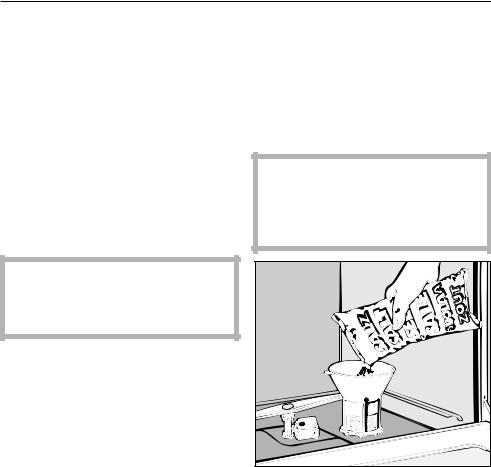
Before using for the first time
Filling the salt reservoir
If your water hardness level is greater than 8 gr/gal, the salt reservoir should be filled before the first use and when the "Salt" indicator lights.
Only use water softener salt specially formulated for dishwashers. Other salts may contain insoluble additives which can impair the water softener.
The proper salt can be purchased from your Miele dealer or Miele’s Technical Service Department.
,Inadvertently filling the salt reservoir with dishwashing detergent will damage the water softener.
To fill the salt reservoir:
^Remove the lower basket.
^Unscrew and remove the salt reservoir cap located on the floor of the wash cabinet.
^Place the provided funnel over the salt reservoir.
The salt reservoir must be filled with 2 quarts (2 l) of water before adding salt for the first time. Water does not have to be added with subsequent refills.
^Carefully fill with salt. The salt reservoir holds approximately 4.5 lbs
(2 kg) of salt. As it is filled, water will run out.
^Clean any excess salt from the threads of the reservoir opening.
^Screw the cap on firmly.
^If the dishwasher will not be used immediately, run the "Rinse & Hold" program. This will remove any traces of salt from inside the wash cabinet.
16
